Food Labels: Defining a New Narrative
Food labels are the must-read material of the millennium, but how valid is the information on food labels and is it effective?

During the halcyon days of bookstores and libraries, dozens of patrons would stand in the aisles between multiple rows of bookshelves with their shoulders hunched and heads bowed, studying the covers and contents of books in an effort to decide whether a book was worth purchasing or borrowing for further reading at home. But these days, bookstores and libraries are rapidly disappearing from the American landscape, leaving consumers with only a few places where it is acceptable to stand in aisles and read. Oddly, an unlikely place is emerging as a prime location for in-the-aisle reading: the supermarket. Despite the digital trend to reduce reading to as few words, characters, and details as possible, modern food labels for packaged foods are accommodating more words and information than ever. In fact, thanks to the abundance of descriptive information on food labels, supermarkets are becoming like bookstores and packaged foods, like books. Which parts of these new reading materials are required and which aren’t? That is, what are the new regulatory changes/additions to food labels and what are industry trends?
Prior to the 1970s, a label on packaged foods was fairly modest; it contained the brand name, a simple description of the type of food in the package, the ingredients, and sometimes, the location of the manufacturer. Since the advent of the new millennium, the food label has become prime real estate for all sorts of descriptive monikers: organic, all-natural, free-range, gluten-free, GMO-free, vegan, doctor-recommended, and so on. And that’s not all: many food labels are filled with short narratives painting an idyllic scene. For example, the package for Eden Dried Cranberries reads, “Organically grown and infused with Eden apple juice concentrate, slowly dried and misted with organic sunflower oil to prevent clumping. Their tangy sweetness is pleasing as they deliver healthy antioxidants.” Similarly, the label for Bob’s Red Mill Natural Granola states, “A scrumptious and easy way to enjoy the goodness of whole grains. Our wholesome granola is perfect to eat as a hot or cold cereal, with yogurt or straight out of the bag. The crunchy clusters and delicate, lightly sweet flavor of this granola will keep you reaching for more. With just a hint of vanilla, No Fat Added Natural Granola uses whole grain oats, crunchy puffed rice and wonderful flavors to create a granola truly worthy of the name.” While these descriptive narratives may make for interesting reading—and might even make a product more popular with consumers—they are clearly not part of the information that is mandated on labels.
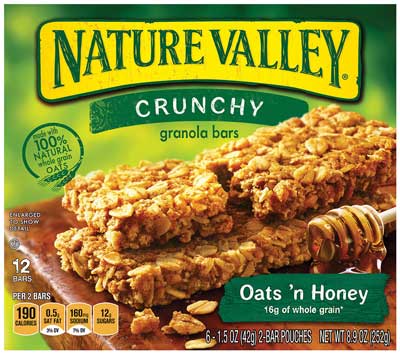 Food Labeling Requirements
Food Labeling Requirements
The U.S. Food and Drug Administration (FDA) is responsible for ensuring that foods sold in the United States are safe and properly labeled. The agency therefore designates what components of a food label are mandatory; however, the FDA does not preapprove food labels. The principal display panel (PDP) of a food label (i.e., the front of the label) must contain the statement of identity, which is the name of a food, and the net quantity of the product. The net quantity should be expressed in both the imperial system of measurement (ounces, pounds, gallons) and the metric system (grams, kilograms, liters). Immediately to the right of the PDP is where the information panel should appear. The information panel should contain 1) the name and address of the manufacturer, packer, or distributor; 2) the list of ingredients; and 3) if applicable, any required allergen information. Under the Food Allergen Labeling and Consumer Protection Act (FALCPA), enacted in 2004, the label of any food that contains a major food allergen, or the protein thereof, must declare the presence of the allergen in the manner described by the law. According to the FALCPA, the major food allergens are milk, eggs, fish, crustacean shellfish (i.e., crab, lobster, or shrimp), tree nuts, peanuts, wheat, and soybeans. Even though more than 160 foods have been identified as allergenic, the major food allergens account for 90% of all food allergies, which is why allergen labeling requirements apply to only those eight food groups. The FALCPA’s labeling requirements apply to prepackaged foods at retail or foodservice establishments but do not apply to fresh fruits and vegetables, highly refined oils derived from one of the major food allergens, and foods that are wrapped or otherwise packaged in response to a consumer’s order.
The fourth requirement on the information panel is the Nutrition Facts label. This label was not mandatory on packaged foods until after passage of the Nutrition Labeling and Education Act (NLEA) in 1990. Before this law, including nutrition information on labels was voluntary and the information would vary from product to product. Often described as the most significant food labeling legislation in five decades, the NLEA was developed to reduce consumer confusion about labels, help consumers make better food choices, and encourage food manufacturers to improve the nutrition profiles of foods. The law not only mandated a standardized format of nutrition labeling on most packaged foods but also specified the nutrients to be listed on the nutrition label, required that nutrients be presented in the context of a daily diet and serving sizes, and set specific requirements for nutrient content claims and acceptable topics for health claims. The NLEA applies only to food products over which the FDA has authority. Labels for meat and poultry products are under the authority of the U.S. Dept. of Agriculture (USDA), and labels for alcoholic beverages are under the authority of the U.S. Alcohol and Tobacco Tax and Trade Bureau. However, the USDA’s Food Safety and Inspection Service collaborated with the FDA to ensure that Nutrition Facts labeling was consistent on meats and poultry.
--- PAGE BREAK ---
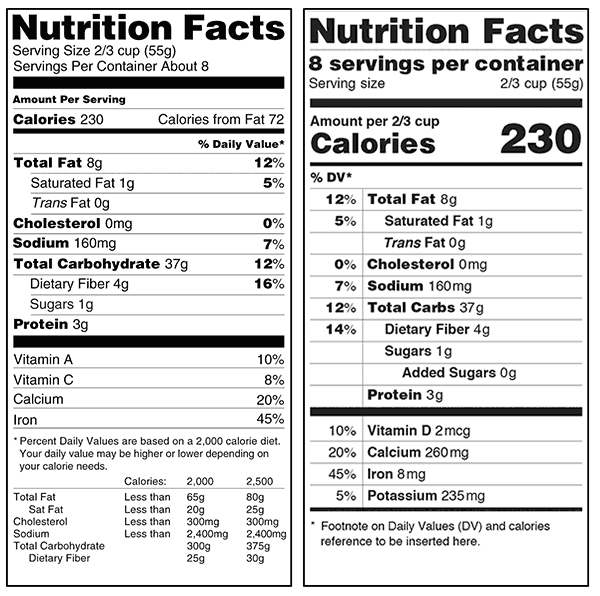 Changes to the Nutrition Facts Panel
Changes to the Nutrition Facts Panel
Since the implementation of the NLEA and Nutrition Facts labels, new research has emerged in nutrition and health science, including more evidence detailing the effects of nutrition on obesity and chronic disease. These new developments have prompted the FDA to propose changes to the Nutrition Facts label. “The Nutrition Facts label had not really been updated in about 20 years,” says Susan Mayne, director of FDA’s Center for Food Safety and Nutrition. “The only real significant change that’s occurred over the last 20 years is that FDA required that trans fat [content] be added to the food label; that happened in 2006. In our country today, chronic diseases account for the primary causes of death. And food and nutrition are some of the modifiable levers we have to reduce the incidence of these chronic diseases.” As a consequence, the proposed changes address factors such as nutrient recommendations, public health concerns, and the need to make nutritional information on food labels more clear and useful.
In March 2014 the FDA issued two proposed rules that would update the Nutrition Facts label. The first rule, “Food Labeling: Revision of the Nutrition and Supplement Facts Label,” would eliminate the requirement to specify the calories from fat. This is because current science indicates that the type of fat is more relevant than overall total fat and because the disclosure of fat-calorie information did not help consumers determine whether a product was healthy or not. Second, this proposed rule would require manufacturers to designate the amount of added sugars in the Nutrition Facts label. “Added sugars could include … cane sugar, beet sugar, brown sugar, dextrose, glucose and lactose; syrups, such as high fructose corn syrup, crystalline fructose, and maple syrup; naturally occurring sugars that are isolated from a whole food and concentrated so that sugar is the primary component, such as fruit juice concentrates; and other caloric sweeteners, including honey, molasses, and table sugar,” says nutrition chemist Roger Legg, co-founder of RL Food Testing Laboratory, Westlake Village, Calif. Many health and nutrition experts advise consuming fewer calories from added sugar because not doing so often results in the decreased consumption of nutrient-rich foods. “In terms of added sugars, the science has been growing for a long time— both in terms of direct effects on health … and in terms of the role of excess calories,” Mayne explains. “It becomes pretty clear that excess intake of added sugars means you’re either going to be consuming too many calories or not taking in the nutrient-dense foods that you need to meet the dietary guidelines’ requirements.” Information on added sugars may also help consumers better implement the recommendations in the U.S. Dietary Guidelines for Americans.
The first rule proposes changing the list of vitamins and minerals of public health significance. The current/original Nutrition Facts label requires the percent daily values of vitamin A, vitamin C, calcium, and iron. After reviewing data from the National Health and Nutrition Examination Survey and other biomarkers, the FDA determined that consumer intakes of vitamins A and C were no longer inadequate but consumer intakes of vitamin D and potassium are. The rule therefore proposes requiring the declaration of the percent daily value for vitamin D, potassium, calcium, and iron on the Nutrition Facts label. “Iron is a nutrient of public health significance, [especially] in younger women. Conversely, in older populations—specifically males—iron is not a nutrient of public health significance,” Mayne says. “Vitamin D is an interesting one because if you look specifically at intake data, it looks like our population is very, very low in terms of the intake of vitamin D. When you look at blood data, however, you get somewhat of a different story.” The declaration of daily value percentages of vitamins A and C would be voluntary, not required. In addition, the reference values used to determine the percent daily values would be changed to reflect updated information on quantitative intakes of nutrients and their association with chronic diseases and other health parameters. This will include lowering the current reference value of sodium from 2,400 mg to 2,300 mg.
 The first proposed rule would also increase the prominence of calorie information, enlarging the font size of the word “calories” and its accompanying numeric value. The font size of the words “servings per container” and its accompanying numeric value would also be increased. Other proposed changes to the appearance of the Nutrition Facts label are moving the percent daily value (% DV) to the left side of the label and removing the required footnote table listing the reference values for certain nutrients for 2,000-calorie and 2,500-calorie diets.
The first proposed rule would also increase the prominence of calorie information, enlarging the font size of the word “calories” and its accompanying numeric value. The font size of the words “servings per container” and its accompanying numeric value would also be increased. Other proposed changes to the appearance of the Nutrition Facts label are moving the percent daily value (% DV) to the left side of the label and removing the required footnote table listing the reference values for certain nutrients for 2,000-calorie and 2,500-calorie diets.
The second proposed rule, “Serving Sizes of Foods That Can Reasonably Be Consumed at One-Eating Occasion; Dual-Column Labeling; Updating, Modifying, and Establishing Certain Reference Amounts Customarily Consumed; Serving Size for Breath Mints; and Technical Amendments,” addresses, among other things, serving size requirements and criteria for labeling according to package size. Because container sizes can influence the amount of food people consume, people are likely to eat an entire container in one sitting. The FDA thus proposes that any container that may be consumed in a single-eating occasion be labeled a single-serving container—even if the container holds a product that has up to 199% of the reference amount customarily consumed. Any container for a product that may be consumed in one or more sittings would have a dual-column Nutrition Facts label featuring a column that lists the quantitative amounts and percent daily values for the entire container as well as a column listing those amounts and percentages per serving. The FDA also proposes changing some of the values of the reference amounts customarily consumed. In addition, the rule recommends technical amendments that clarify serving-size regulations.
In July 2015 the FDA issued a proposed rule revising some aspects of the rule “Food Labeling: Revision of the Nutrition and Supplement Facts Label.” The FDA is proposing, among other things, to include the percent daily value for added sugars on the Nutrition Facts label of packaged foods. The agency reasons that this will provide consumers with the type of information they already see on the labels for nutrients such as sodium and certain fats. The percent daily value of added sugars would be based on the recommendation that a daily intake of calories from added sugars should not exceed 10% of total calories. The effective date for these proposed rules would be 60 days after publishing of the final rules in the Federal Register, and all food labels would need to be in compliance two years after the effective date.
The FDA says the benefits of both rules would far outweigh the costs, but some industry players disagree, particularly with respect to added sugars. In comments submitted to the FDA, the Grocery Manufacturers Association (GMA) expresses that most of its members do not believe a mandatory declaration of added sugars will help customers maintain healthful dietary practices. The organization is concerned that the declaration could lead to consumer confusion—especially since scientific research indicates that controlling obesity requires balancing calories consumed and calories expended: “Consumers need calorie information, not added sugar information,” GMA states in its comments. Legg provides context for the GMA’s position: “From a formulation perspective, there is no difference between sugars and added sugars, and there is no laboratory test that can differentiate between a naturally occurring sugar and an added sugar.” And in response to the FDA’s assessment that the proposed rules would result in a one-time cost of $2.3 billion to industry for label redesign, product reformulation, and initial record-keeping, GMA believes the agency’s cost assessment is understated.
--- PAGE BREAK ---
Labeling Requirements for Menus and Vending Machines
Supermarket food aisles are not the only retail food establishments with extra reading material, and the NLEA is not the only law governing food labeling. The Patient Protection and Affordable Care Act was signed into law in March 2010, and section 4205 of the act specifies requirements for nutrition labeling on restaurant menus. The purpose of the law’s requirements is to provide accurate and consistent nutrition information that enables consumers to make healthful dietary choices. The requirements apply to restaurants or retail food establishments serving restaurant-type food (for example, bakeries, cafeterias, coffee shops, convenience stores, and so on, but not schools) with 20 or more locations doing business under the same name and vending machine operators that manage 20 or more vending machines. Restaurants and vending machine operations that fall within this category must disclose calorie and other nutrition information for standard menu items. Foodservice operations that are not subject to this requirement (i.e., those with less than 20 locations or less than 20 vending machines) may elect to become subject to the law’s requirements by voluntarily registering with the FDA every other year.
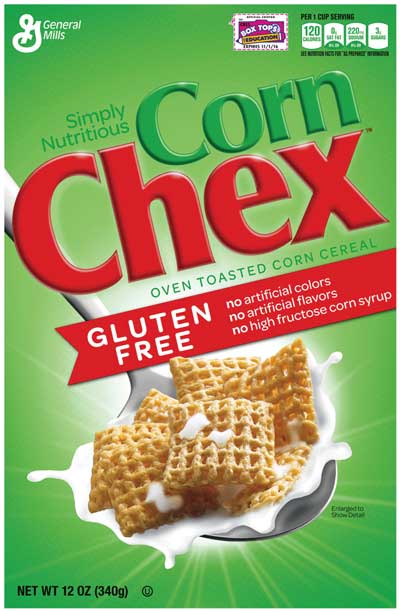 In December 2014 the FDA issued a final rule for implementation of menu labeling. The final rule indicates that the food and beverages subject to nutrition labeling requirements are standard menu items, not daily specials, temporary menu items, or custom orders and that the calories of such foods must be declared on menus and menu boards. Among other things, the rule also specifies that menus and menu boards must display a succinct statement of the suggested daily caloric intake and that nutrition information must be available in written form for consumers who request it. The written nutrition information must encompass values for calories, calories from fat, total fat, saturated fat, trans fat, cholesterol, sodium, total carbohydrate, dietary fiber, sugars, and protein, and there should be a reasonable basis (e.g., nutrient databases and laboratory analyses) for the determination of nutrient values. The final rule also explains specific nutrition labeling requirements for self-service food and beverages. The effective date of the menu-labeling rule is December 1, 2015, and food establishments must be in compliance with the rule by December 1, 2016.
In December 2014 the FDA issued a final rule for implementation of menu labeling. The final rule indicates that the food and beverages subject to nutrition labeling requirements are standard menu items, not daily specials, temporary menu items, or custom orders and that the calories of such foods must be declared on menus and menu boards. Among other things, the rule also specifies that menus and menu boards must display a succinct statement of the suggested daily caloric intake and that nutrition information must be available in written form for consumers who request it. The written nutrition information must encompass values for calories, calories from fat, total fat, saturated fat, trans fat, cholesterol, sodium, total carbohydrate, dietary fiber, sugars, and protein, and there should be a reasonable basis (e.g., nutrient databases and laboratory analyses) for the determination of nutrient values. The final rule also explains specific nutrition labeling requirements for self-service food and beverages. The effective date of the menu-labeling rule is December 1, 2015, and food establishments must be in compliance with the rule by December 1, 2016.
The FDA also issued in December 2014 a final rule for implementation of calorie labeling of food in vending machines. Among other things, the final rule defines a vending machine operator as a person or entity that controls or directs the function of a vending machine and indicates that the calorie declaration of foods within a vending machine must be clear and prominently placed. The goal of these requirements as well as those for menu labeling is to provide consumers with nutrition information prior to purchase. “The menu labeling and vending-machine rules are just recognizing trends in consumption in the [United States] today. People are eating more and more out of the home: they’re eating more in restaurants; they’re eating more food out of vending machines,” Mayne summarizes. “The consumer needs to have that information prior to selecting. So giving consumers nutrition information so that they can make informed choices is all part of that.”
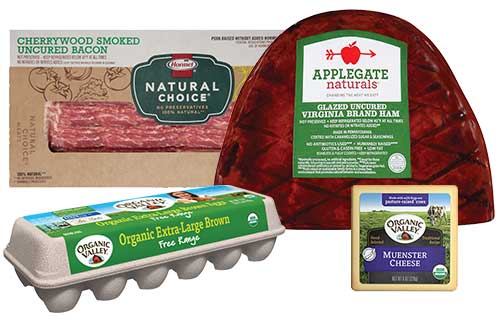 Identifying What’s Clean, Clear, or Ethical
Identifying What’s Clean, Clear, or Ethical
The FDA and USDA are not the only entities dictating the language on food labels; consumers and consumer advocacy groups are also having a say. It seems that a contingent of active and vocal consumers are establishing a trend that involves increasing the availability of healthy, all-natural food options with clean labels. Their advocacy and purchasing power influence how foods are labeled. As a consequence, besides ensuring that labels for packaged foods contain mandatory nutrition information, food manufacturers are adding to food labels supplementary messaging that appeals to consumers. This translates to numerous label terms that market foods as natural, all-natural, organic, made with whole grains, gluten-free, safe, simple, pure, free-range, humanely raised, antibiotic-free, and so on. Almost all of these monikers are unregulated, unofficial/nonauthoritative designations designed to catch the attention of consumers. There are a few exceptions. The FDA has specific requirements for use of the terms “free,” “low,” “reduced,” and “less” in conjunction with calories and the following nutrients: cholesterol, fat, saturated fat, sodium, and sugar. The other exception is the organic label; foods certified organic must adhere to strict regulatory standards developed by the USDA’s National Organic Program.
While it has yet to be determined how much importance consumers place on the authoritative nutritional information and guidance on food labels, it is evident that consumers place great emphasis on unofficial, unregulated label designations. In fact, many consumers perceive these terms on food packages as an indication that a food is safe, healthy, minimally processed, or congruent with their personal food beliefs. Two of the biggest labeling culprits that convey information that is taken as authoritative—but isn’t—are GMO labeling and natural or clean labeling.
Despite the fact that the FDA, the National Academy of Sciences, the American Association for the Advancement of Science, and the World Health Organization all agree that genetically engineered foods are safe for consumption, fear and suspicion of bioengineered crops (i.e., genetically modified organisms [GMOs]) persist. Widespread misinformation about genetic engineering of plants and crops perpetuates the stigma that genetically engineered crops are unsafe and continues to energize the movement for mandatory labeling of all GMOs and foods containing genetically engineered ingredients. Plants and crops have undergone various forms of genetic modification for centuries, and bioengineering is no different, yet companies have submitted 27,000 food products for non-GMO certification labels in the past five years (Saletan 2015). In 2013, Whole Foods Market, Austin, Texas, announced plans to require all labeled products in its stores to indicate whether they contain GMOs by 2018, and Chipotle, Denver, Colo., announced earlier this year that it would use only non-GMO ingredients in its restaurants. Moreover, Vermont, Connecticut, and Maine have passed laws requiring GMO labels on food products containing GMO ingredients, and state bills supporting GMO labeling are working their way through the legislatures of 16 states, including Alaska, Hawaii, Illinois, Massachusetts, and New York (CFS 2015). Food companies are concerned about this growing patchwork of GMO labeling laws, which will require them to print different labels in certain states for food products that require no specialized labeling in other states, but a resolution could be near: a federal bill that is co-sponsored by U.S. Representatives Mike Pompeo (R-Kan.) and G. K. Butterfield (D-N.C.).
H.R. 1599, the Safe and Accurate Food Labeling Act, would establish a federal labeling standard for foods with genetically engineered ingredients, rendering existing state-enacted GMO laws invalid and preventing other states from passing such laws. In its current form, the law would give the FDA sole authority to require mandatory labeling of such foods if scientific evidence ever proved that they were unsafe or materially different from foods not made with genetically engineered ingredients and would make GMO labeling voluntary for food companies. The law would also create a voluntary non-GMO certification system at the USDA. In July 2015 the U.S. House of Representatives passed the bill by a vote of 275 to 150. In a press statement, Pompeo said, “This bill, supported by over 400 groups that provide safe and affordable food for our world, will eliminate the state-by-state labeling patchwork that would serve to confuse consumers, stigmatize GMO crops, and raise food costs” (Pompeo 2015). Whether the measure is passed by the U.S. Senate remains to be seen as a senate version of the bill has not been introduced at the time of this article’s development.
--- PAGE BREAK ---
Unlike GMO labeling, clean labeling—a term used to describe food labels containing natural or simple ingredients—is a standard being embraced across the food industry. During the IFT15 show, Lu Ann Williams, director of innovation at Innova Market Insights, said that clean labeling “has moved past being a trend. It is the new rule” (IFT 2015). Last year, more than 20% of new U.S. products featured clean labeling, and there has been a significant increase in food manufacturers’ use of natural ingredients. With regard to the terms “natural” and “all-natural,” the FDA remains firm on offering only guidance (use of the terms is not objectionable if “the food does not contain added color, artificial flavors, or synthetic substances”) rather than a legal definition. This allows food manufacturers to interpret natural, clean labels in ways that benefit their brands and products.
However, consumer advocacy groups and determined consumers on social media platforms are influencing companies’ interpretations. As a consequence, many food manufacturers are removing artificial colors, flavors, and preservatives from their food products. In February 2015 Nestlé USA, Glendale, Calif., committed to removing artificial flavors and FDA-certified colors from all Nestlé chocolate candies by the end of the year. In April 2015 Kraft Foods Group, Northfield, Ill., announced that, beginning in 2016, it will no longer use artificial flavors and preservatives and synthetic colors in its Original Kraft Macaroni & Cheese. The company’s line of boxed shapes macaroni and cheese dinners was rendered free of artificial flavors and preservatives and synthetic colors earlier this year. And in June 2015 General Mills, Minneapolis, Minn., announced that it would be removing artificial flavors and colors from the 40% of its cereals that contain them: “In recent years, we’ve heard that artificial ingredients aren’t what you are looking for in your bowl. … [W]e are committing to remove artificial flavors and colors from artificial sources from the rest of General Mills cereals” (Hunt 2015). The products that have already made these transitions have labels to reflect their status.
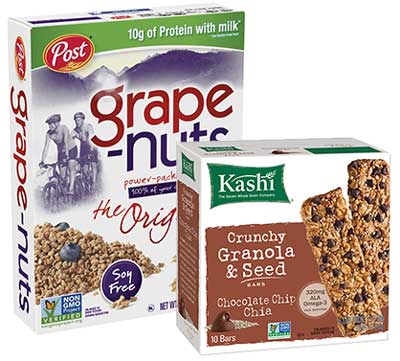 Labels claiming that foods are free of GMOs, artificial colors and flavors, and preservatives are also part of another popular trend: free-from (or free-of) labels. According to Mintel, Americans believe free-from foods are more natural, less processed, and better for their health. In fact, 43% of consumers believe that foods with free-from claims on labels are healthier than foods without free-from claims. Besides GMO-free, other popular free-from terms on labels are gluten-free, trans fat-free, preservative-free, and allergen-free. Free-from claims not only indicate the absence of certain ingredients in food products but also address consumers’ personal food beliefs or ethical values. Mintel’s research suggests that consumers are patronizing food companies that care about the environment as well as promote better health. As a consequence, cage-free, free-range, and cruelty-free are popular claims on eggs as well as other animal products.
Labels claiming that foods are free of GMOs, artificial colors and flavors, and preservatives are also part of another popular trend: free-from (or free-of) labels. According to Mintel, Americans believe free-from foods are more natural, less processed, and better for their health. In fact, 43% of consumers believe that foods with free-from claims on labels are healthier than foods without free-from claims. Besides GMO-free, other popular free-from terms on labels are gluten-free, trans fat-free, preservative-free, and allergen-free. Free-from claims not only indicate the absence of certain ingredients in food products but also address consumers’ personal food beliefs or ethical values. Mintel’s research suggests that consumers are patronizing food companies that care about the environment as well as promote better health. As a consequence, cage-free, free-range, and cruelty-free are popular claims on eggs as well as other animal products.
Once a plain canvas on which little information was conveyed, the food label has evolved into prime real estate where food policy regulators, advocacy groups, and food marketers all compete for consumers’ attention. Food policy mandates may have commandeered areas on food labels, menus, and vending machines, but there is still plenty of space available for messaging that influences consumer decisions. “We’re interested in labeling foods in a way that consumers can have the information to make appropriate health choices,” says Mayne. Hopefully other interested parties can say the same.
Toni Tarver is senior writer/editor of Food Technology magazine ([email protected]).
References
CFS. 2015. State labeling legislation map. Center for Food Safety. http://salsa3.salsalabs.com/o/1881/p/salsa/web/common/public/content?content_item_KEY=13981.
Hunt, K. 2015. “A Big Commitment for Big G Cereal.” General Mills blog, June 22. http://blog.generalmills.com/2015/06/a-big-commitment-for-big-gcereal/.
IFT. 2015. “Innova Gives the ‘All Clear’ for a New Industry Standard.” IFT15 News, July 12. http://news.ift.org/tag/innova-market-insights/.
Pompeo, M. 2015. “Pompeo Applauds Passage of Safe and Accurate Food Labeling Act.” Press release, July 23. http://pompeo.house.gov/news/documentsingle.aspx?DocumentID=398519.
Saletan, W. 2015. “Unhealthy Fixation.” Slate, July 15. http://www.slate.com/articles/health_and_science/science/2015/07/are_gmos_safe_yes_the_case_against_them_is_full_of_fraud_lies_and_errors.html.
